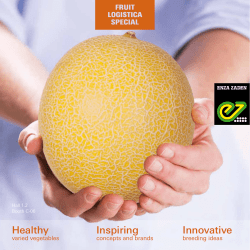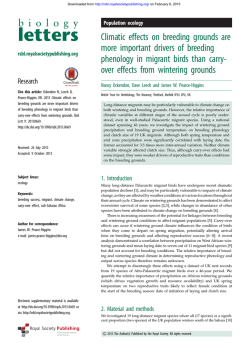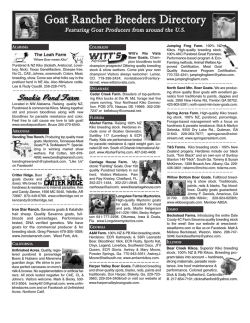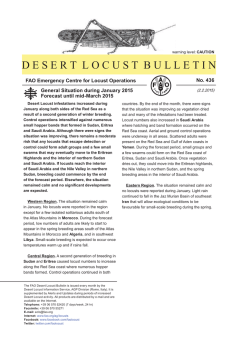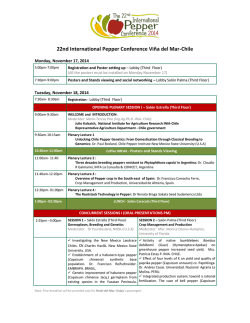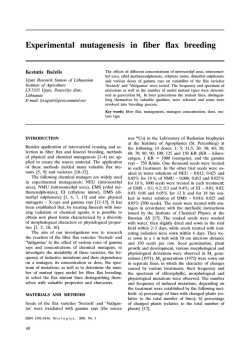
PowerPoint-presentatie
Breeding a better pig in a changing global market Dr Jan ten Napel 18th March, 2015 Animal Breeding & Genomics Centre Introduction Commercial pig production is changing worldwide A genetic programme is a design tool to change characteristics in a population Objective ● Overview of what is currently being done to breed pigs that are suitable for the production systems and conditions of future generations Animal Breeding & Genomics Centre Global developments in pig production Economy ● Scale enlargement ● Rapid expansion in Russia, China and Brazil ● Country-specific in EU, but decreasing ● Concentration (BE, DE, FR, NL, PT, ...) ● Abandonment (DK, ES, IT, UK, ...) ● Re-structuring (CR,PL) Animal Breeding & Genomics Centre Global developments in pig production Markets ● Increase in niche markets ● Organic production ● Local produce ● Low-cost production of commodity Society ● Concerns about public health: use of antibiotics ● Concerns about animal welfare: tail docking, castration Animal Breeding & Genomics Centre Global developments in pig production Pig breeding and genetics ● Consolidation through mergers and take-overs ● Increasing scale of business ● Globally operating ● Introduction of expensive techniques, such as large-scale genotyping of the whole genome ● So fewer and larger breeding organisations serve a wider range of markets worldwide ● Trade will be increasingly with grandparent stock Animal Breeding & Genomics Centre Breeding for the future Five generations of pigs is seven years in practice What should be changed through genetic selection? ● Better health of pigs ● Better resource efficiency ● Maintain a reasonable profitability ● More acceptable to society and consumers ● All of this in a wider range of production systems and markets in the world Focus of current research Animal Breeding & Genomics Centre Breeding for better health A healthy pig ● Does not get clinical symptoms for pathogens that are common in the herd ● Deals with an infection with minimal loss of production Breeding for healthy pigs ● Creates a good starting position ● Needs the right management to become effective ● Difficult in practice, but not impossible Animal Breeding & Genomics Centre Study of Herreiro et al. 2014 on litter size There is genetic variation in ability to maintain productivity in harsh environments Animal Breeding & Genomics Centre Breeding for better resource efficiency Minimal wastage (loss of animals, loss of production) ● Viability of pigs ● Mothering ability ● Predictability of production ● Positive social interactions Ability to utilise locally available feed stuff ● Availability of high quality protein (or lack of it) Increased productivity ● Improved efficiency per kg product Animal Breeding & Genomics Centre Genetic correlations between growth rate in different group sizes in the same pen Growth rate with competition (groups of 16) and without competition (groups of 13) are different traits Animal Breeding & Genomics Centre Breeding for acceptable pork production No need to castrate – breeding for a low boar taint ● Boar taint is caused by skatole and androstenone ● Some boars have a reduced clearance of skatole if androstenone in the liver increases ● Strongly heritable ● Requires a different way to select against boar taint than often suggested Animal Breeding & Genomics Centre Crossbred progeny of high and low boartaint sires Animal Breeding & Genomics Centre Breeding for a reasonable profitability Anticipate on changing consumer preferences ● Maximise carcass revenue Minimise cost of production ● Reduce the need for individual management of sows through breeding ● Predictability models ● Improve productivity in diverse and dynamic conditions Animal Breeding & Genomics Centre Improving productivity It is a pattern, not an incident: +0.2 pigs born per litter in the Netherlands Animal Breeding & Genomics Centre New tools for genetic improvement Genomic selection changes the common practice in animal breeding ● Utilising detailed DNA information to estimate genetic merit ● It means reliable breeding values already at birth ● Helpful for traits expressed in one sex or late in life ● Application across breeds and crosses ● Research: new knowledge, new tools Animal Breeding & Genomics Centre Breed4Food Public-private partnership ● Four Dutch-based animal breeding companies ● Wageningen UR Three major research areas ● Exploiting DNA information ● Enabling new breeding goal traits ● Adding value to the chain Aim: enhance genetic improvement for a sustainable and profitable livestock sector, meeting societal challenges Animal Breeding & Genomics Centre Conclusions Dutch pig breeding companies focus on breeding pigs that are able to produce in a wide range of climates and production conditions Pigs from such a genetic programme should adapt without problems and be productive in Spanish conditions Current research focuses on all main aspects of sustainability and acceptability to society and consumers Animal Breeding & Genomics Centre Dutch genetics Breeding for sustainable pig production – now and in the future Animal Breeding & Genomics Centre
© Copyright 2025
